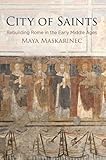City of Saints : Rebuilding Rome in the Early Middle Ages / Maya Maskarinec.
Material type: TextSeries: The Middle Ages SeriesPublisher: Philadelphia : University of Pennsylvania Press, [2018]Copyright date: ©2018Description: 1 online resource (320 p.) : 21 color, 33 b/w illusContent type:
TextSeries: The Middle Ages SeriesPublisher: Philadelphia : University of Pennsylvania Press, [2018]Copyright date: ©2018Description: 1 online resource (320 p.) : 21 color, 33 b/w illusContent type: - 9780812294958
- Christian saints -- Cult -- Italy -- Rome -- History
- Christianity -- Social aspects -- Europe -- History -- To 1500
- Christianity -- Social aspects -- Italy -- Rome -- History
- Archaeology
- History-Ancient/Classical up to 500 CE
- History-Medieval 500 to 1500
- HISTORY / Medieval
- Ancient Studies
- Archaeology
- Classics
- History
- Medieval and Renaissance Studies
- Religion
- 235/.2094563209021 23
- online - DeGruyter
| Item type | Current library | Call number | URL | Status | Notes | Barcode | |
|---|---|---|---|---|---|---|---|
 eBook
eBook
|
Biblioteca "Angelicum" Pont. Univ. S.Tommaso d'Aquino Nuvola online | online - DeGruyter (Browse shelf(Opens below)) | Online access | Not for loan (Accesso limitato) | Accesso per gli utenti autorizzati / Access for authorized users | (dgr)9780812294958 |
Frontmatter -- Contents -- Introduction -- Chapter 1. A City of Saints -- Chapter 2. Imperial Saints Triumphant in the Forum Romanum -- Chapter 3. St. Caesarius on the Palatine: Enriching Rome by Imperial Orders -- Chapter 4. Miraculous Charity Along the Tiber’s Banks -- Chapter 5. Fashioning Saints for the Affluent on the Aventine Hill -- Chapter 6. Collectivities of Sanctity in Early Medieval Rome -- Chapter 7. Carolingian Romes Outside of Rome -- Chapter 8. A Universalizing Rome Through the Lens of Ado of Vienne -- Epilogue -- Appendix 1. Saints from Abroad Venerated in Rome, ca. 500–800 -- Appendix 2. Theodotus and S. Angelo in Pescheria -- Appendix 3. The Translatio of St. Caesarius from Terracina to Rome -- Appendix 4. The Spread of St. George’s Cult -- Appendix 5. An Early Medieval Diaconia Dedicated to St. Nicholas? -- Appendix 6. The Passio of St. Boniface of Tarsus -- Abbreviations -- Notes -- Bibliography -- Index -- Acknowledgments
restricted access online access with authorization star
http://purl.org/coar/access_right/c_16ec
It was far from inevitable that Rome would emerge as the spiritual center of Western Christianity in the early Middle Ages. After the move of the Empire's capital to Constantinople in the fourth century and the Gothic Wars in the sixth century, Rome was gradually depleted physically, economically, and politically. How then, asks Maya Maskarinec, did this exhausted city, with limited Christian presence, transform over the course of the sixth through ninth centuries into a seemingly inexhaustible reservoir of sanctity?Conventional narratives explain the rise of Christian Rome as resulting from an increasingly powerful papacy. In City of Saints, Maskarinec looks outward, to examine how Rome interacted with the wider Mediterranean world in the Byzantine period. During the early Middle Ages, the city imported dozens of saints and their legends, naturalized them, and physically layered their cults onto the city's imperial and sacred topography. Maskarinec documents Rome's spectacular physical transformation, drawing on church architecture, frescoes, mosaics, inscriptions, Greek and Latin hagiographical texts, and less-studied documents that attest to the commemoration of these foreign saints. These sources reveal a vibrant plurality of voices—Byzantine administrators, refugees, aristocrats, monks, pilgrims, and others—who shaped a distinctly Roman version of Christianity. City of Saints extends its analysis to the end of the ninth century, when the city's ties to the Byzantine world weakened. Rome's political and economic orbits moved toward the Carolingian world, where the saints' cults circulated, valorizing Rome's burgeoning claims as a microcosm of the "universal" Christian church.
Mode of access: Internet via World Wide Web.
In English.
Description based on online resource; title from PDF title page (publisher's Web site, viewed 04. Okt 2022)


